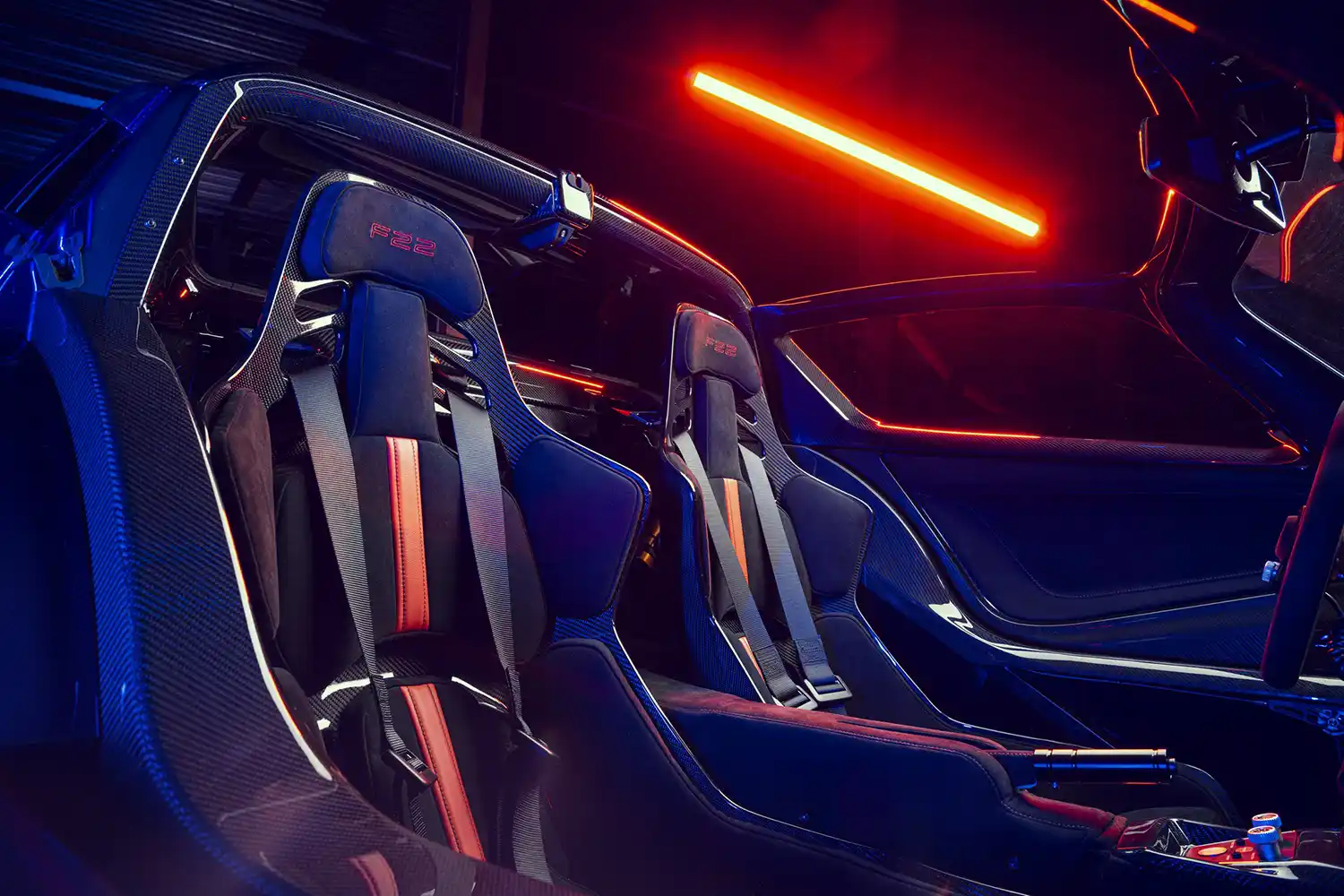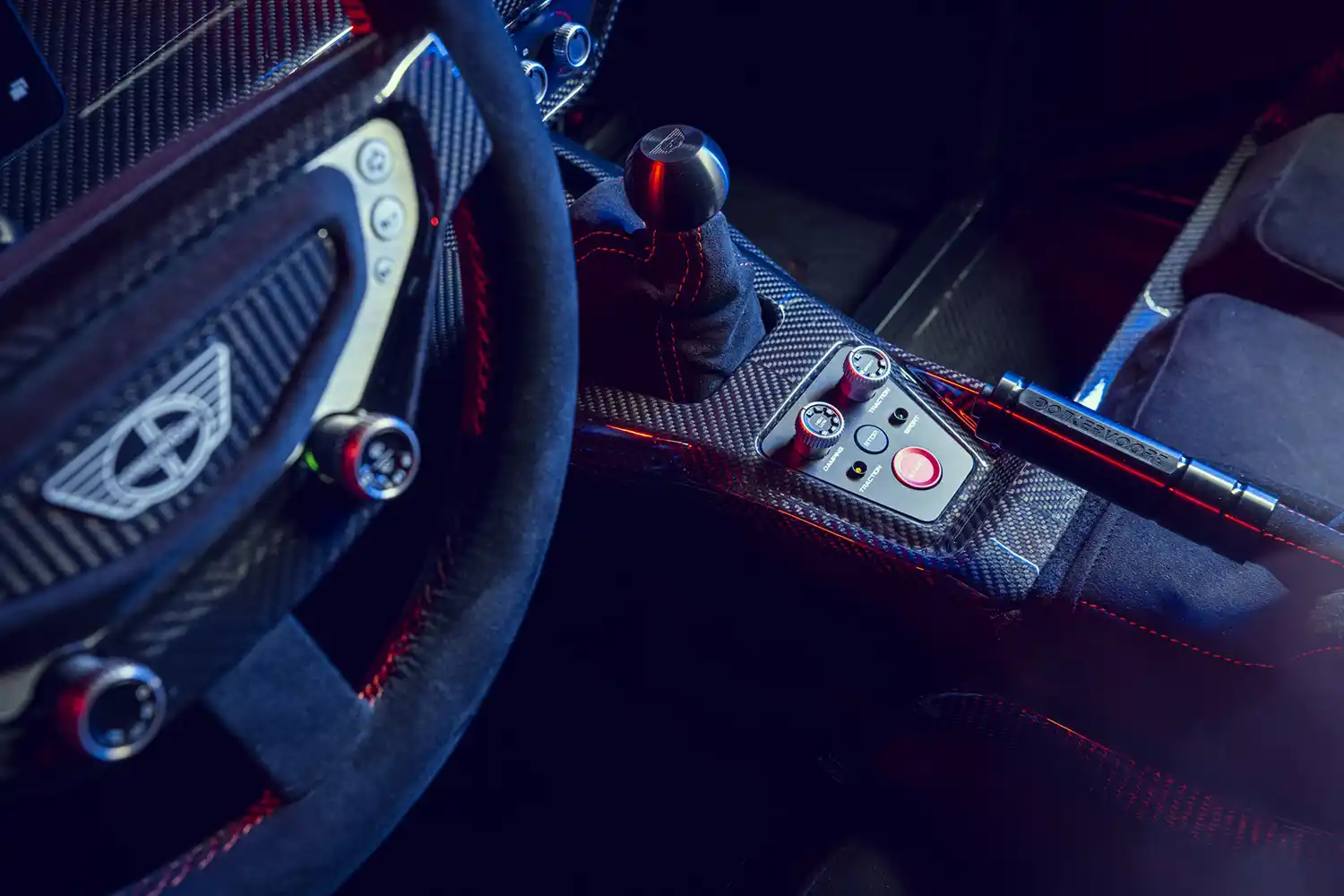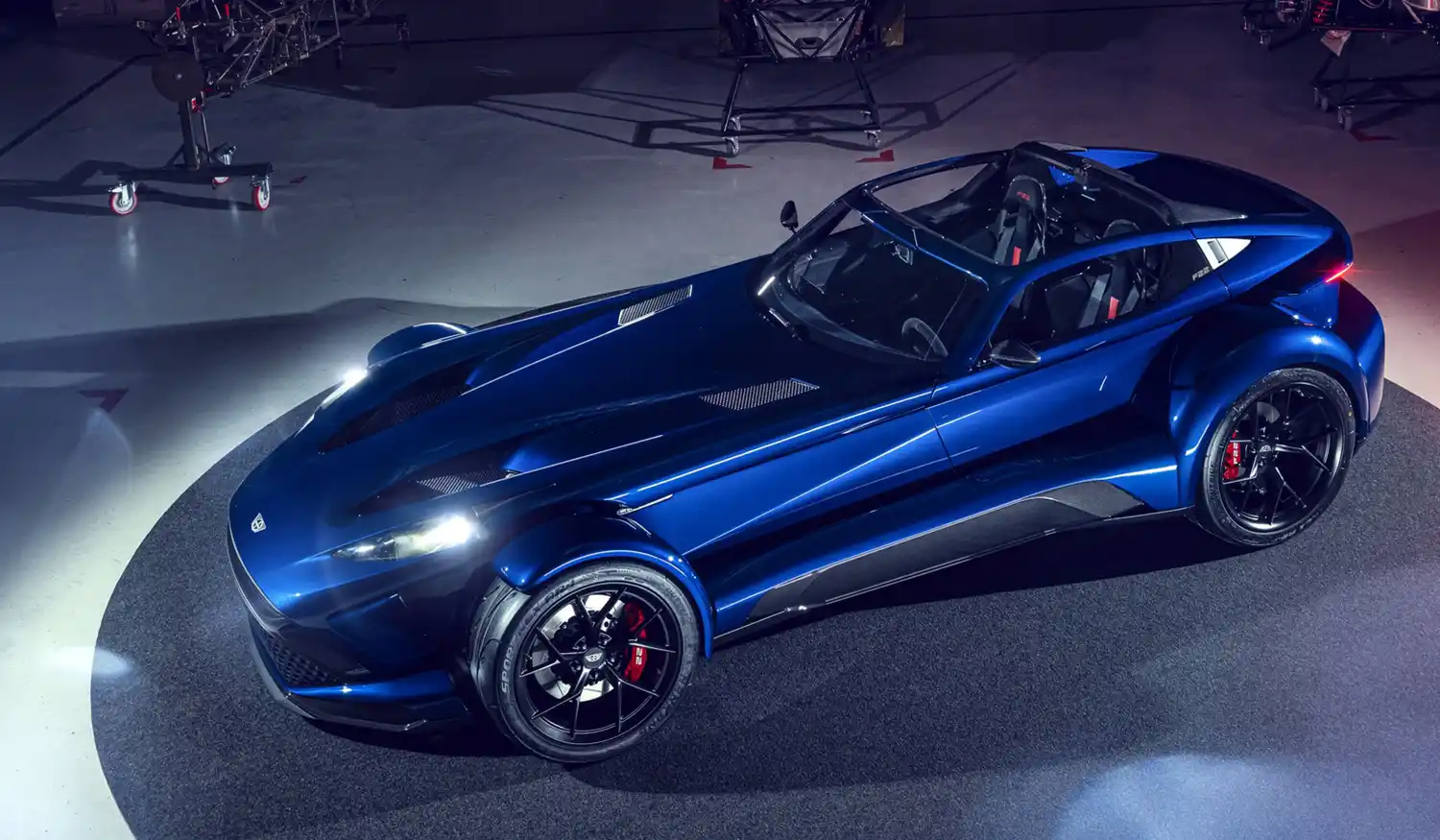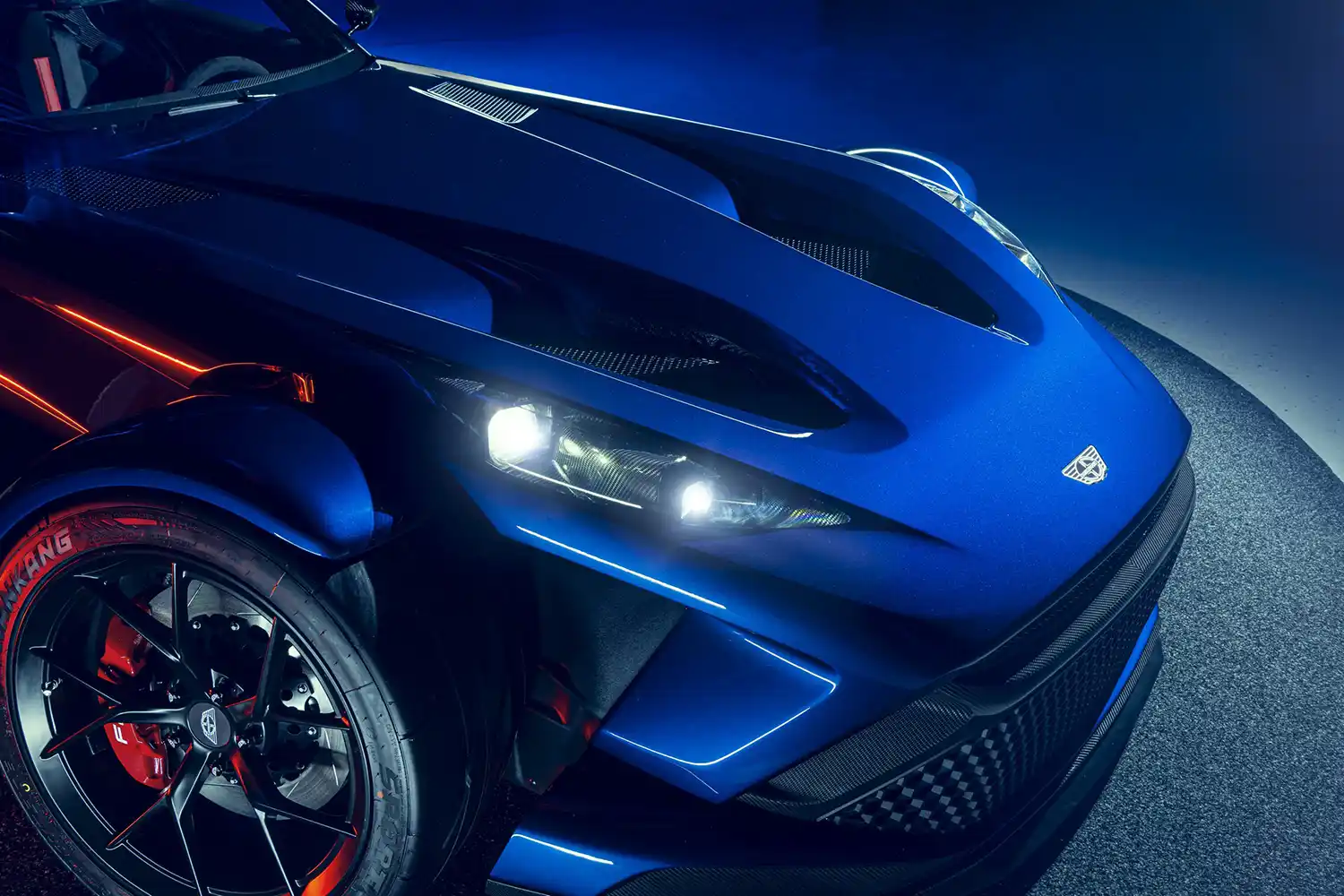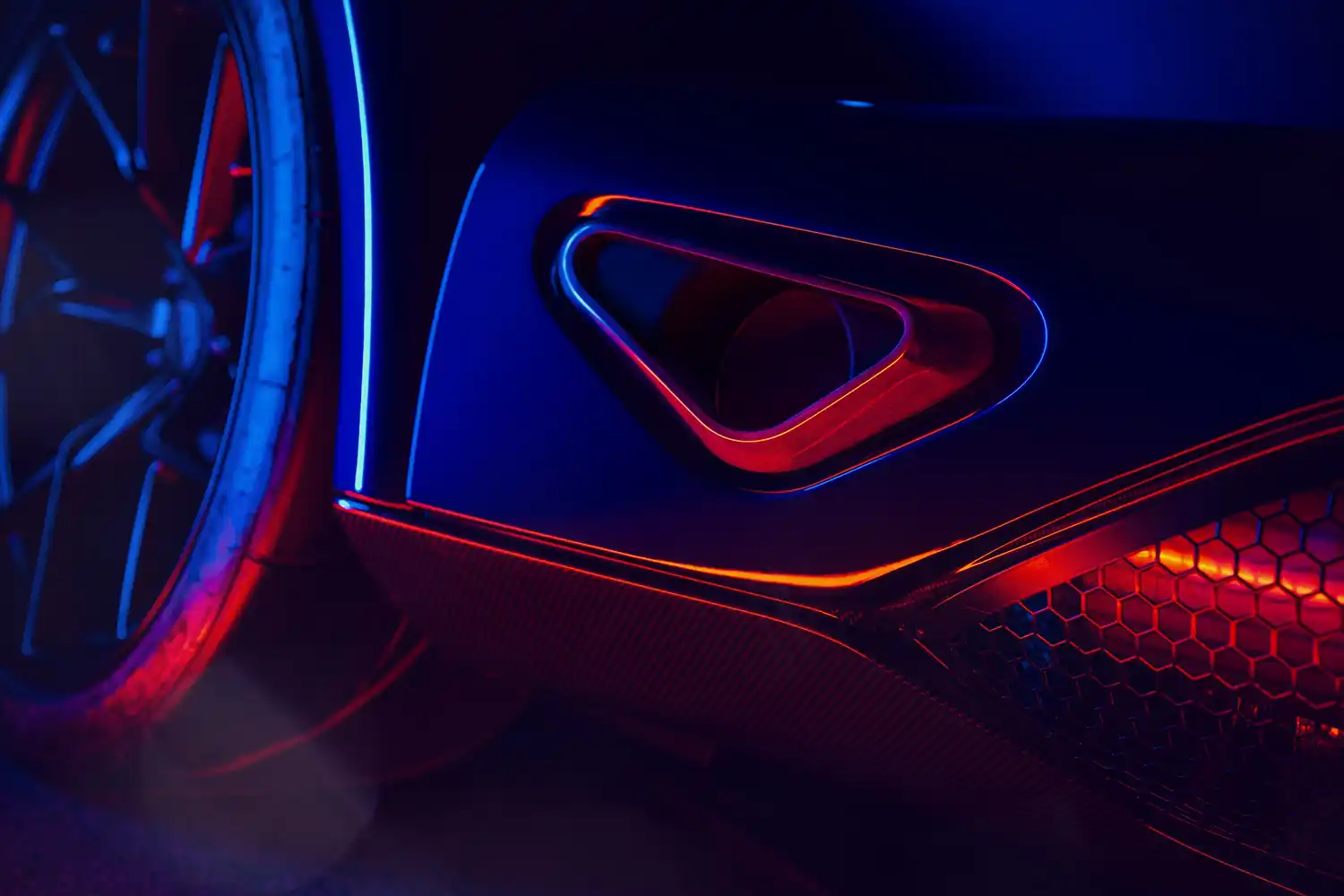
Under the direction of second-generation Managing Director Denis Donkervoort, the family-owned Dutch boutique brand has created a supercar that breaks new ground in every area, from construction to design.
With 500 horsepower from its five-cylinder turbo motor and weighing just 750kg, the innovative Donkervoort F22 combines stunning design, sheer speed, handling purity and everyday usability while retaining links to Donkervoort’s historic open-wheel layout.
Donkervoort has redefined driving purity by doubling the F22’s torsional and bending rigidity (compared to the outgoing D8 GTO Individual Series), thanks to a hybrid chassis construction of thin-wall steel tube and Ex-Core carbon-fibre chassis construction.
The F22 supercar is capable of hitting 2.15G of lateral acceleration while remaining the lightest road- registered, two-seat supercar in the world.
The Donkervoort F22 became the first Donkervoort to be sold out based on design sketches alone before the car was even seen.
Donkervoort Ambassador program members snapped up the entire planned 50-unit production run, forcing the Donkervoort to extend production to 75 cars. The F22 is the first new model since Denis Donkervoort took over as the company’s driving force after his father’s retirement, Donkervoort Automobielen founder Joop Donkervoort, early in 2021 and marks the end of the D8 GTO era.
An accomplished racer as well as Donkervoort’s Managing Director, Denis Donkervoort’s engineering brief called for even more track pace, greater comfort, ease of use at the limit and more practicality based on a safer, stronger car wrapped up in a revolutionary design.
Determined to show their passion had only grown under new management, the Donkervoort engineering and design departments raised their game to new s with the F22 program.
“The F22 is the pinnacle of what we know with light-weight engineering, strength, combustion engines and pure speed,” Donkervoort insisted.
“The F22 gives Donkervoort drivers new levels of speed, handling, driving purity, design and practicality, and shows the world where Donkervoort is going in the future. It is brimming with Donkervoort innovations, like the Ex-Core carbon-fibre doors and the Twin Targa roof, but it also is the product of extraordinary teamwork at Donkervoort and leverages working relationships we have made over 43 years. With the arrival of the Donkervoort F22, no other supercar is worth its weight,” he said.
With 500 horsepower from its five-cylinder turbo motor, the rear-drive F22 delivers an astonishing power-to-weight ratio of 666hp per tonne.
With no speed limiter, the F22 is expected to reach a top speed of around 290km/h.
Yet Donkervoort’s widespread use of innovative materials and a friction-eradication program helped the F22 to achieve a confirmed WLTP CO2 emissions figure of just 163 grams/kg – around 28 grams lower than its predecessor, despite gaining 55kg.
It retains the unrivalled driving intimacy of a pure mechanical driveline, with a rev-matched, five-speed manual gearbox driving the rear wheels through a new limited-slip Torsen differential.
And, in keeping with family tradition, the Donkervoort F22 is named for Denis Donkervoort’s first daughter, Filippa, who was born on May 22, 2022.
Still, the most driver-focused, rear-drive supercar money can buy, the Donkervoort F22s will be sold everywhere from North America to the Middle East and Europe, starting at €245,000 in European markets (including preparation costs, but excluding taxes and on-road costs).
The initial sold-out response to the first batch of F22s also prompted Donkervoort to open up its interest-registration program for both the F22’s successors as well as the remaining F22 allocations.

Powertrain and performance
The heart of the Donkervoort F22 powertrain is the front mid-engined five-cylinder turbocharged engine.
The in-line engine was originally built by Audi Sport, and Donkervoort engineers have tuned it for even more power, torque and low-end drivability.
It boasts 500 horsepower – in a machine weighing just 750kg.
The F22 development had an extreme obsession with weight reduction – even by Donkervoort standards – as the car grew physically larger to accommodate owner requests and legislation from three continents.
The potent engine was one of the key advantages in the weight-saving campaign, with Donkervoort avoiding hybrid and electric powertrains and the hundreds of kilograms they would have added.
Donkervoort also proved that the 2.5-litre engine still had more efficiency, even with a boost in power. The F22 has a homologated WLTP combined emissions figure of 163 grams of CO2 per kilometre – 28 fewer than its 695kg predecessor.
The five-cylinder engine’s bore and stroke are unchanged, and it runs a 10.0:1 compression ratio to deliver a mountain of torque from very low in the rev range.
The enormous torque from low revs, combined with the car’s ultra-lightweight, means the F22 can utilise the size and weight efficiencies of the five-speed gearbox.
Besides saving at least 12kg over a six- or seven-speed gearbox, the shorter five-speed unit means the F22 can carry the engine further rearward, in a front-mid engine position, to optimise its balance and handling.
The short-throw gearbox utilises Bosch rev-matching technology, with the option to switch it off to allow drivers to use their heel-and-toe skills.
The gearbox and engine mate to a taut Torsen limited-slip differential, encased in new housing that no longer requires an additional cooling system for concentrated track work. The new housing is stronger and helps minimise drive-line noise in the passenger compartment.
The Donkervoort F22 retains the multi-step traction-control system, which can be adjusted to suit the driver’s mood or road conditions.

Chassis engineering
While the Donkervoort D8 GTO-JD70 was the first supercar to cross the 2G cornering threshold, the sophistication of the F22’s all-new chassis takes extreme grip even further to 2.15g.
But, critically, the F22 adds an entirely new dimension of day-to-day liveability and versatility when it is not driven to the outer limits of its abilities.
The chassis is a hybrid of tubular steel and a generous serving of Donkervoort’s renowned carbon-fibre abilities, including the liberal use of the breakthrough Ex-Core carbon sandwich system.
The result is a body-in-white with a 100-percent boost in torsional and bending rigidity over the outgoing D8 GTO Individual Series and commensurate increases in both active and passive safety.
This ultra-stiff core chassis delivers a quantum leap in handling and suspension accuracy while remaining ultra-light.
“The key to everything we do is weight. The less weight you carry, the less weight you have to stop, turn and accelerate, and the less fuel you use and the more intimate the car can be,” Donkervoort explained.
“The F22 is not all about horsepower or speed, specifications or numbers. It’s personal, and it’s about what driving means to its drivers because perspective is everything,” he said.
Donkervoort has built on this philosophy by deploying a new active shock absorber system to deliver at both the calmest and most frenzied extremes of a driver’s demands.
“We wanted the active ride for many years because, at a track day, you had to adjust the ride and dampers manually, but now you can do that from the cockpit,” he said.
The new dampers include an adjustable hydraulic ride- system, which can raise or lower the F22 by as much as 35mm.
It also brings a new AP Racing braking system into play, with steel discs and a four-piston front caliper setup, saving 10kg over the already-featherweight system on the outgoing car.
Just as critically, the braking performance has improved by 30 percent over the outgoing D8 GTO Individual Series system.
After using the Nankang AR-1 on its predecessor, Donkervoort built on the relationship with its official tyre supplier by developing custom AR-1 tyres for the ultra-lightweight F22 and going up an inch in tyre diameter.
While alloy wheels are standard equipment, the F22 can be fitted with either forged rims or carbon-fibre rims, both of which save weight where it counts most and add rigidity.
The standard alloy rim is 12kg, the forged alloy weighs 8kg per wheel, while the carbon-fibre rims are just 5,4kg per wheel.
Dimensions and interior
The all-new Donkervoort F22 has grown up in most dimensions to meet homologation standards as far afield as the USA and the United Arab Emirates.
Yet its overall weight remains convincingly light at 750kg, making it easily the lightest two-seat machine in the supercar sector.
The Donkervoort F22 has grown to 4039mm in overall length, and it is 1912mm wide and 1105mm high, making it longer, wider and taller than its predecessor.
The two-door F22 has a significantly larger cabin, with the extra 80mm of shoulder width and 100mm of cabin length almost all given over the, creating a more comfortable interior.
The completely new interior uses optional custom-designed, lightweight Recaro seats and the first six- point harnesses approved both for racing and road use.
The Twin Targa uses two carbon-fibre roof plates on either side of a removable central Ex-Core carbon- fibre bar. Each roof plate contains its own small spoiler for high-speed stability and noise reduction, and each can be removed with three manual latches. The roof plates can be stored in a matching bag to fit the luggage compartment.
The central bar can be detached via an electronically powered button, as can the single-piece, front- hinged bonnet.

Design
The longer, sleeker, more aggressive-looking F22 pays tribute to Donkervoort’s history while laying down a design marker for its future.
Some of the highlights of the design include a new three-piece Twin Targa carbon-fibre removable roof, the retention of an open-wheel layout and a more spacious, comfortable interior.
Most switches move to the steering wheel, while the cleaner dash design features an optional integrated iPad Mini infotainment system.
Five years in the making, the F22’s design comes from a collaboration between Donkervoort Technical Director Jordi Wiersma, Managing Director Denis Donkervoort and Design Director Europe of Ford, Amko Leenarts.
While Wiersma has long-driven design and innovation at Donkervoort, Leenarts is a long-term Donkervoort fan, sits on Donkervoort’s Advisory Board and has a critical role to play as a sounding board and a creative sparring partner.
The Donkervoort F22 has emerged as a more modern interpretation of the legendary open front-wheel design concept, beloved by traditional Donkervoort buyers, that also opens the door to a new level of speed and sophistication at Donkervoort.
The extra 264mm of length over its predecessor has been used to sculpt a slipperier aerodynamic surface for the four-metre F22, helping it to faster track times with added aerodynamic stability.
It has also added 100mm to the interior length, making the F22 comfortable for taller drivers.
“We made use of Ex-Core and added strength and created an integrated design that links to our heritage while advancing the F22’s design,” Wiersma said. “We tried to make something much more modern and integrated with elements from the past so that the design was completely new and modern while referencing our long heritage. The Twin Targa roof system is all new, and it adds a lot for Donkervoort drivers, and it also adds bending rigidity to the chassis.”
The front end is entirely new, and Donkervoort has a unique process for its rear lights that span the rear wings of the F22, certifying each tail light individually.
There is far more rake on the windscreen, with its Ex-Core carbon-fibre frame, than on any previous Donkervoort. It is integrated deeply into the chassis for added strength and visual cohesion.
The F22 has design references from the legendary 2007 Donkervoort D8 GT; the first Donkervoort Wiersma worked on.
“The GT was my first car, and we thought about the great things on that car, like the wings over the rear wheels and the hard-top roof. The Twin Targa gives us the best of both worlds, with the ability to be a coupe and a roadster. We also took the wings over the wheels from the GT to give us a better aerodynamic profile for the air behind the wheel and a stronger stance at the rear.”
The guiding checkpoints were set down for the F22 during Wednesday night meetings, even during online sessions during the pandemic.
“Initially, the idea was to do something simple and clean, but Amko pulled us out of that. We want to feel that there is a lot of space, and Amko helped us work on that idea to create a sense of space in a smaller area. We filled the dash the other way around, and suddenly we had so much more space and connected all the lines for a feeling of safety.”
The two design leaders were given their lead by Denis Donkervoort but emerged from the F22 process with nothing but respect for each other.
“Jordi is such a wonderful, extremely capable designer and engineer,” Leenarts said.
“He knows how parts go together, how to make things beautiful and translate that into something truly feasible. The way the F22 exterior is, I pushed for the same philosophy in the interior. It’s good to have beautiful jewellery, but we pushed to have a less busy interior that felt more integrated. Now it embraces the passenger and driver in a way that feels much bigger, with fewer pieces and a more cohesive feel.”
Safety
The Donkervoort F22’s safety integrity has moved the game on for ultra-lightweight supercars, both its active and passive safety.
With torsional rigidity rising from 20,000Nm/degree to 40,000 and bending stiffness doubling, the F22 provides a rock-solid platform for all the evasive moves a driver might need to take in an emergency.
“We took much care to improve safety,” Donkervoort said.
“Torsional rigidity is critical, and all the F22’s crucial parts are now made from Ex-Core. The undertray that covers the tubular parts of the chassis, the side panels, the central bar of the Twin Targa roof and the scuttle; they’re all Ex-Core.”
The symmetrical design also uses the side-exiting exhaust pipe as a crash box for side-impact protection on the left side, adding strength to the Ex-Core side rails.
The F22 also integrates the ultra-strong Ex-Core sandwich-construction, carbon-fibre segments with tube-steel sections in a hybrid chassis construction.
Ex-Core is a Donkervoort innovation that has been spun off into its own stand-alone company, and it is used by everything for Formula One, other hypercar brands and even ocean-racing yachts.
Ex-Core can even create zero-radius creases in carbon-fibre by lining the inside of carbon fibre sheets with a foam that expands with heat, so it pushes the carbon fibre layers out into the corners of the mould. The foam then solidifies, remaining inside the carbon-fibre parts to add strength and durability while reducing vibrations.
The astonishing strength of the chassis, with double the torsional and bending rigidity of its predecessor, combines with the standard six-point harnesses to help the F22 meet all relevant crash regulations without the need for weighty airbags.
“There is no denying the added safety that comes with a six-point harness,” Donkervoort said.
“Our data showed 98% of our buyers chose the optional six-point harness over the standard three-point harness for their D8 GTO-JD70s, so we certified a new six-point harness for all types of use.”
- Customisation and ownership
The Donkervoort F22 is inarguably the most driver-focused supercar money can buy, with a uniquely pure level of driver involvement. - The F22 also opens the door to the world of hypercar customization.
- The F22 supercar can be customised and personalised by its owners long before a single piece of carbon-fibre or leather has even been measured.
- There are core choices to make for F22 buyers, including whether they prefer a steering system with no servo assistance or a lightweight, electronically powered, adjustable power-assistance system.
- There is a choice between an electrically powered air conditioning system or the slight weight advantage that comes without it.
- There are other driver-choice options, like a Bosch ABS system, for those who frequently enjoy track days.
- Beyond that, even the smallest detail of the F22 can be customised, from one-off paintwork and interior design to embossing the owner’s initials or business logo into the seat trims.
- Another key point with ownership is incredible longevity. The repair-ability of Donkervoorts means more than 99 percent of all Donkervoorts ever built are still on the road as appreciating assets.
All in the family
The F22 is named after Filippa, born this year as the first child of Donkervoort Managing Director Denis Donkervoort.
The Donkervoort S8A and the S8AT were both named for Amber Donkervoort, the daughter of Donkervoort founder Joop Donkervoort.
The “D” from the D10 lineage onwards came from Denis Donkervoort, now Donkervoort’s Managing Director.
Donkervoort was founded by Joop Donkervoort in 1978, and it is still owned by the Donkervoort family.
